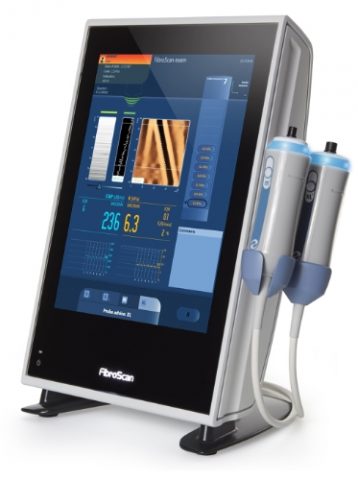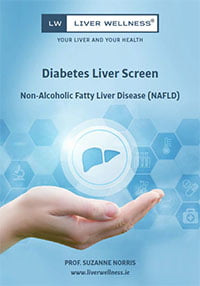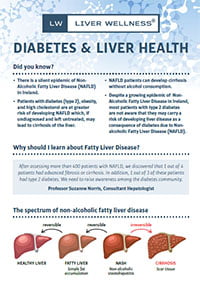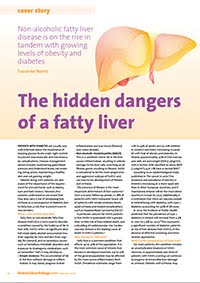Did you know?
Why should I learn about Non-Alcoholic Fatty Liver Disease?
After assessing more than 400 patients with NAFLD, we discovered that 1 out of 4 patients had advanced fibrosis or cirrhosis. In addition, 1 out of 3 of these patients had type 2 diabetes. We need to raise awareness among the diabetes community.
The spectrum of Non-Alcoholic Fatty Liver Disease

Facts of Non-Alcoholic Fatty Liver Disease
How can I be screened for NAFLD?
FibroScan Liver Assessment
A 15 minute non-invasive, pain free liver scan
FibroScan® Assessments can be accessed by referral through the Public Hospital System and also directly at some Private Hospitals, including the Liver Wellness clinics in Blackrock Clinic and Beacon Hospital.
Click here to book an appointment.
There is a silent epidemic of Non-Alcoholic Fatty Liver Disease (NAFLD) in
Ireland and patients with type 2 diabetes, obesity, and high cholesterol are at
greater risk of developing this disease which, if undiagnosed and left untreated,
may lead to cirrhosis of the liver.
International Clinical Practice Guidelines now recommend that screening for
NAFLD should be part of routine work-up in patients with type 2 diabetes, obesity, and metabolic syndrome.
Your liver is a vital organ that performs many essential functions. It is the largest solid organ in the body, and is located under your rib cage on the upper right side. Your liver processes everything you eat, drink, breathe, and absorb through your skin. It turns nutrients into energy your body can use, and removes harmful substances from your blood.
Fat can build up in the liver due to alcohol consumption and by increasing body weight. When fat makes up more than 10% of the liver’s weight, it is called Fatty Liver Disease. If the extra fat is not caused by drinking too much alcohol, the disease is called Non-Alcoholic Fatty Liver Disease (NAFLD).
People with certain medical conditions are at higher risk for developing NAFLD,
including:
• Type 2 Diabetes
• Obesity
• High Cholesterol
• High Blood Pressure
• High Triglycerides
Yes, studies indicate that approximately 25% of the adult population in most countries in Europe and the US have NAFLD, and the incidence is increasing in parallel with increasing rates of diabetes and obesity.
In Ireland, approximately 225,000 people have diabetes (mostly type 2 diabetes), and up to 80% of patients with type 2 diabetes have fat in their liver. Two thirds of diabetes patients older than 50 years are estimated to have NAFLD with advanced liver scarring or fibrosis.
If someone has NAFLD for a long time, the liver can become damaged from scarring of the liver (fibrosis). If this involves all of the liver and becomes
irreversible, it is called cirrhosis. Patients with type 2 diabetes who do not
drink alcohol can still develop cirrhosis because of fat related inflammation and scarring. This sub-type of NAFLD is called NASH, or Non-Alcoholic Steatohepatitis, and has a higher risk for liver scarring and progression to liver failure compared to patients who have simple fat in their liver with no inflammation.
NAFLD and NASH do not always cause cirrhosis; however, over 20–30 years,
cirrhosis can occur. Cirrhosis is a risk factor for liver failure and liver cancer.
Like many liver diseases, NAFLD and NASH are “silent” diseases, which means that people who have them often do not feel sick until they have significant liver damage. Because the awareness of the risk of liver disease due to NAFLD in patients with diabetes is low, patients may not be screened for liver problems. Sometimes, NAFLD is diagnosed when tests are done for other reasons (medical insurance, occupational health screen). NAFLD often causes no symptoms. If symptoms do occur, they tend to be non-specific such as fatigue, a dull ache in the upper right abdomen, sleep apnoea, and achy joints.
A liver ultrasound scan is often the first test to diagnose NAFLD but it cannot
detect how much scar tissue (fibrosis) has developed.
Liver blood tests (ALT, AST) may be abnormal in NAFLD patients but research
has shown that up to 80% of patients with NAFLD and liver damage can
have normal liver blood tests. So liver blood tests are not a sensitive test for screening diabetic patients for NAFLD.
A liver biopsy is an accurate test but may be painful.
A FibroScan® assessment is a painless non-invasive alternative to detecting
liver fat and fibrosis (scarring). International Clinical Guidelines
recommended the FibroScan® assessment as a validated non-invasive procedure for the identification of patients at risk of NAFLD.
Weight reduction is the key factor in treating NAFLD. Studies have proven that losing 7–10% body weight reduces liver fat, reduces liver inflammation and liver scarring.
Patients with diabetes and or high cholesterol should control these conditions. Uncontrolled diabetes or high cholesterol can lead to progressive liver disease.





